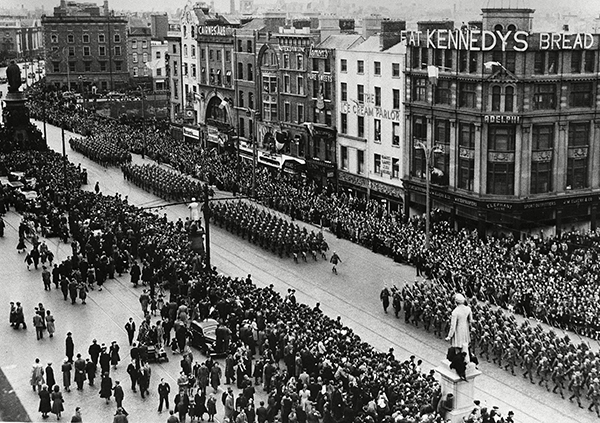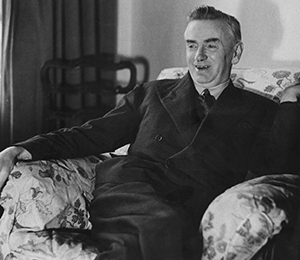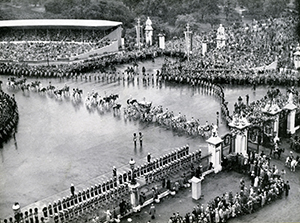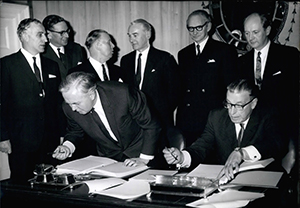Ireland, 1949–73—a closet member of the Commonwealth?
Published in Features, Issue 1 (January/February 2020), Volume 28How much did Irish relations with the Commonwealth change after 1949?
By Ben Wynne
The history of Ireland’s membership of the Commonwealth is well known but the country’s relations with the Commonwealth after 1949 have received less attention. In 1948 the Commonwealth consisted of the United Kingdom, Canada, Australia, New Zealand, South Africa and, following their recent independence, India, Pakistan and Ceylon (now Sri Lanka). Ireland’s status was ambiguous. In 1948 British officials, working on possible arrangements for India’s continuing membership of the Commonwealth, defined Commonwealth members as sharing allegiance to the British crown, common citizenship, economic cooperation, consultation on foreign policy and defence collaboration. Ireland had considered itself to be ‘associated’ with the Commonwealth since at the latest 1937, when a republican constitution was introduced. A tenuous link with the British crown existed in the Executive Authority (External Relations) Act 1936, which provided for the accreditation of diplomats to and from Ireland in the name of the British monarch. Ireland did not, of course, contribute to Commonwealth defence, being neutral during the Second World War. It was, however, part of the Commonwealth’s system of preferential trade tariffs and the sterling financial area. Irish citizens were also regarded as British subjects until 1948, when new Commonwealth arrangements accorded Irish citizens the same rights as British subjects in Commonwealth countries.

Above: Irish troops parade along O’Connell Street to celebrate the birth of the Republic of Ireland on 18 April 1949. (Shutterstock)
Repeal the External Relations Act
This situation was called into question when Taoiseach John A. Costello, on a visit to Canada, let it slip on 7 September 1948 that his new government intended to repeal the External Relations Act. During the negotiations that followed it became clear that, although the Irish government was not interested in membership of the Commonwealth, it did want the practical benefits of membership. This primarily meant the trade preferences and citizenship rights. Published research demonstrates that thanks to support from Australia in particular, mindful of the political clout of Irish Australians, the Irish government was successful in achieving its aims despite initial British resistance. Ireland continued to be part of Commonwealth trading arrangements and Irish citizens continued to be treated under the laws of Commonwealth countries as if they were Commonwealth citizens rather than ‘aliens’. Ireland reciprocated these rights and also remained a member of the sterling financial area (Ireland’s membership does not seem to have arisen as part of the negotiations). Britain continued to manage its relations with Ireland through its Commonwealth Relations Office until 1968, when it and the Foreign Office were merged.
It is striking from the sources how little the Irish government wanted to change relations with the Commonwealth. In his speech to the Dáil on 24 November 1948 introducing the Republic of Ireland bill, Costello went out of his way to stress the ‘ties of friendship and kinship’ and the ‘economic, social and trade relations’ that underpinned a ‘specially close relationship’ with the Commonwealth. There was a delicate balance to be struck, however. The government was so successful in retaining the substance of Ireland’s Commonwealth status that it was keen that no doubt should arise as to whether Ireland had actually left! On 20 November 1948, the private secretary of the Minister for External Affairs wrote to Commonwealth ministers that ‘… it is hoped that, while making it clear that Commonwealth countries do not, and will not, treat Ireland as a “foreign” country and vice versa, nothing will be said by the Commonwealth governments which would tend to create controversy as to Ireland’s position after the repeal of the Act’. On 9 September 1949, the Department for External Affairs summarised Ireland’s remaining links with the Commonwealth for the cabinet. The author was keen to make it clear from the outset that the country had ‘no constitutional relationship to Britain and the Dominions’ and then went on to list many areas in which co-operation continued. As well as the citizenship, trade and financial arrangements, these areas included shipping, aviation, social security, judicial co-operation and postal services. The government soon overcame its concern about how Ireland’s Commonwealth status would be perceived and advertised Ireland’s preferential access to Commonwealth markets when seeking to attract foreign investors during the 1950s and 1960s.

Above: Taoiseach John A. Costello—in his speech to the Dáil on 24 November 1948, introducing the Republic of Ireland bill, Costello went out of his way to stress the ‘ties of friendship and kinship’ and the ‘economic, social and trade relations’ that underpinned a ‘specially close relationship’ with the Commonwealth.
Defence
After the Second World War, regional defence pacts became far more important to Commonwealth countries than Commonwealth defence arrangements. In Europe, of course, that meant NATO. While Ireland did not join NATO, it did collaborate discreetly with Britain on defence. In 1952 the Irish government was pressing the British government for supplies of arms. In 1953 the Irish government agreed to co-operate with Britain on the evacuation of women and children to Ireland in the event of war, on the mutual exchange of weather reports (as had been done during the Second World War) and on the stationing of British ‘shipping advisors’ in Ireland. Irish defence force personnel—particularly naval staff—received training in Britain. The British continued to recruit Irish citizens to their armed forces, as they had done since Irish independence. In a House of Commons statement on 3 November 1954, the Under-Secretary of State for War, Mr Fitzroy Maclean, noted that ‘citizens of that Republic serve in the British Army on exactly the same terms as citizens of the United Kingdom. … I should like to say how glad the British Army is to receive recruits from Southern Ireland.’
People more generally continued to be important links between Ireland and Commonwealth countries after 1949. For example, in 1959 alone 64,494 Irish people emigrated to Britain—almost as many as from the entire Commonwealth and colonies. Irish people also emigrated to other Commonwealth countries but complete figures are not available for this, as much of this emigration took place via Britain. According to the Irish Times of 4 February 1955, however, ‘it is well-recognised that there is a constant flow of Irishmen from a variety of trades and professions to these countries’.
Of the five characteristics of a Commonwealth member defined in 1948, Ireland clearly continued to display two after 1949—common citizenship (through shared citizenship arrangements) and economic cooperation. It also collaborated discreetly with Britain on defence. Allegiance to the British crown no longer applied after 1950, when India became a republic within the Commonwealth. The only characteristic that did not apply to Ireland was consultation on foreign policy.

Above: The royal coach returns to Buckingham Palace after the coronation of Queen Elizabeth II on 2 June 1953. The Irish ambassador was ‘plagued with applications from Irish citizens for seats on the coronation route’. Although offered the same number of seats as Commonwealth countries, the Irish government did not accept any. (Alamy)
hanges
Some things did change, however. Ireland was no longer represented at official Commonwealth meetings. In any case, Ireland had only been represented at such meetings by its high commissioner in London—if at all—since Fianna Fáil came to power in 1932 (Fianna Fáil ministers did, however, attend the Commonwealth economic conference in Ottawa in 1932). After 1949 ways were found to get around this issue when necessary. For example, Irish and British ministers met in February 1952 to discuss one of the regular sterling crises of those years following a Commonwealth finance ministers’ meeting on the matter in January. Irish representation at ceremonial events even reared its head. In August 1952 a British official consulted the Irish ambassador in London on Irish representation at the coronation of Queen Elizabeth II and appeared to raise the possibility of Ireland being allocated the same number of audience seats on the processional route as Commonwealth countries. (Ireland’s representative in London was designated ‘ambassador’ from 26 July 1950 in place of the earlier title of ‘high commissioner’, which only applied between Commonwealth countries. The change made little practical difference, as high commissioners and ambassadors had had the same diplomatic status since October 1948.) The ambassador noted to his colleague in Dublin that he was ‘plagued with applications from Irish citizens for seats on the coronation route’. In the event, the government did not accept any seats, let alone a ‘Commonwealth allocation’; neither was any member of the government present at the ceremony, in protest against the partition of the island of Ireland and the use of the name ‘Northern Ireland’ in the queen’s title (the Irish ambassador did, however, attend). The Irish ambassador in London asked that the fact that Ireland had been offered seats be kept quiet.
There was more to Commonwealth meetings than government conferences and royal ceremonial, however. There were also meetings of many Commonwealth associations and networking groups and Ireland continued to be represented at some of these. For example, Trinity College and the National University of Ireland sent observers to the congress of the Association of Universities of the British Commonwealth in Cambridge in July 1953. In October 1968 the former Taoiseach, Seán Lemass, and Eileen Desmond, a Labour Party TD, attended a meeting in the Bahamas of the Commonwealth Parliamentary Association, of which Ireland was an associate member. In the 1950s Ireland’s ambassador in Paris regularly attended informal dinners of Commonwealth ambassadors in the city.
So smooth was Ireland’s transition from semi-detached member of the Commonwealth to Commonwealth status without membership that some contemporaries began to question what being a member of the Commonwealth actually meant. Hedley Bull, who was to become a leading scholar of international relations, wrote in World Politics in 1959: ‘think away the Commonwealth and most of these links [between Commonwealth countries] remain as, indeed, most of them have remained in the case of Éire …’. Nicholas Mansergh, in a history of the Commonwealth published in 1969, described Ireland’s membership as ‘an artificially imposed superstructure’ on friendly relations with Commonwealth countries. Ireland was not unique in this. During 1966, officials of the Commonwealth Relations Office reviewed how important individual members considered the Commonwealth to be and concluded that for most countries what mattered were bilateral relations with Britain and not the Commonwealth.
At a public panel discussion in February 1960 at which the possibility of Ireland rejoining the Commonwealth was raised, Noel Browne TD expressed the view that Ireland was still a member of the Commonwealth economically and that he could see little advantage in rejoining officially. To borrow a phrase familiar from Britain’s negotiations to leave the European Union, Ireland was both ‘having its cake and eating it’. Ireland’s Commonwealth status began to fade during the 1960s, however, as the Commonwealth itself changed. Commonwealth trading arrangements were increasingly superseded by the General Agreement on Tariffs and Trade (GATT) and regional trading agreements. Britain’s trade with the developed economies of Western Europe grew much faster than trade with the largely primary-commodity-producing economies of the Commonwealth. Britain became a founding member of the European Free Trade Association in 1960 and both Britain and Ireland first applied to join the European Economic Community in 1961.

Above: Prime Minister Harold Wilson and Taoiseach Seán Lemass sign the Anglo-Irish Trade Agreement on 12 December 1965. By 1970 Ireland was Britain’s largest ‘Commonwealth’ export market. (Alamy)
Sterling
The sterling financial area also weakened. In an era when the value of most currencies was fixed to the pound sterling or the US dollar, Britain’s regular trade deficits led to ‘sterling crises’ when a sterling devaluation was feared. The British government levied surcharges on imports in 1964 to reduce the deficit—including on imports from the Commonwealth and Ireland. In 1966 ‘voluntary’ restrictions were put on British investment in the developed economies of the sterling area, including Ireland. Both these measures represented a fundamental change in Britain’s economic relations with the Commonwealth and Ireland. They failed to reduce pressure on the pound, however, and it was devalued from £2.80 to £2.40 against the dollar on 18 November 1967. Ireland immediately devalued the Irish pound in line with sterling. Eventually fixed exchange rates could not be sustained by either sterling or the dollar and the United States abandoned the system in 1972. This brought an end to the sterling area, but Ireland did not break its link with sterling until 1979, when the Irish pound joined the European Monetary System.
As the countries of the Commonwealth drifted away from each other economically, Ireland and Britain ironically became even more closely linked. Ireland responded to the growing liberalisation of European trade by concluding new trade agreements with Britain in 1960 and 1965—the latter provided for the gradual elimination of tariffs and quota restrictions by 1975. The 1960 agreement was concluded under the wing of the Commonwealth Relations Office and the 1965 agreement at prime ministerial level. Trade between Ireland and Britain grew. Trade statistics collated by the Bank of England show that in 1948 Ireland was Britain’s fourth-largest Commonwealth export market by value, after Australia, South Africa and India. By 1970 it was Britain’s largest ‘Commonwealth’ export market. Both Ireland and Britain finally joined the European Economic Community in 1973.
So, how significant a turning point in relations between Ireland and the Commonwealth was Ireland’s departure in 1949? The declaration of a republic certainly ended a long process of constitutional adjustment with Britain that started with independence in 1922, but Ireland effectively retained its Commonwealth status. In fact, Ireland never officially declared that it had left the Commonwealth because by 1948 it considered that it was ‘associated’ with the Commonwealth. It was only when the Commonwealth’s economic underpinnings were superseded by developments in the wider world economy that Ireland left the Commonwealth’s orbit, exchanging Commonwealth status for membership of the European Economic Community—both arrangements in which Ireland’s relations with Britain were of central importance. The difference was that Ireland was a full and active member of the European Economic Community rather than the closet member of the Commonwealth that it had been from 1949 to 1973.
Ben Wynne is a former librarian and a history graduate of Trinity College, Dublin.
FURTHER READING
Documents on Irish foreign policy, Vol. IX, 1948–51, Vol. X, 1951–7, Vol. XI, 1957–61 (Dublin, 2014–18).
East of Suez and the Commonwealth, 1964–1971 (part III), in British Documents on the End of Empire, Series A, Vol. 5 (London, 2004).
The Labour government and the end of empire, 1945–1951 (part IV), in British Documents on the End of Empire, Series A, Vol. 2 (London, 1992).
















